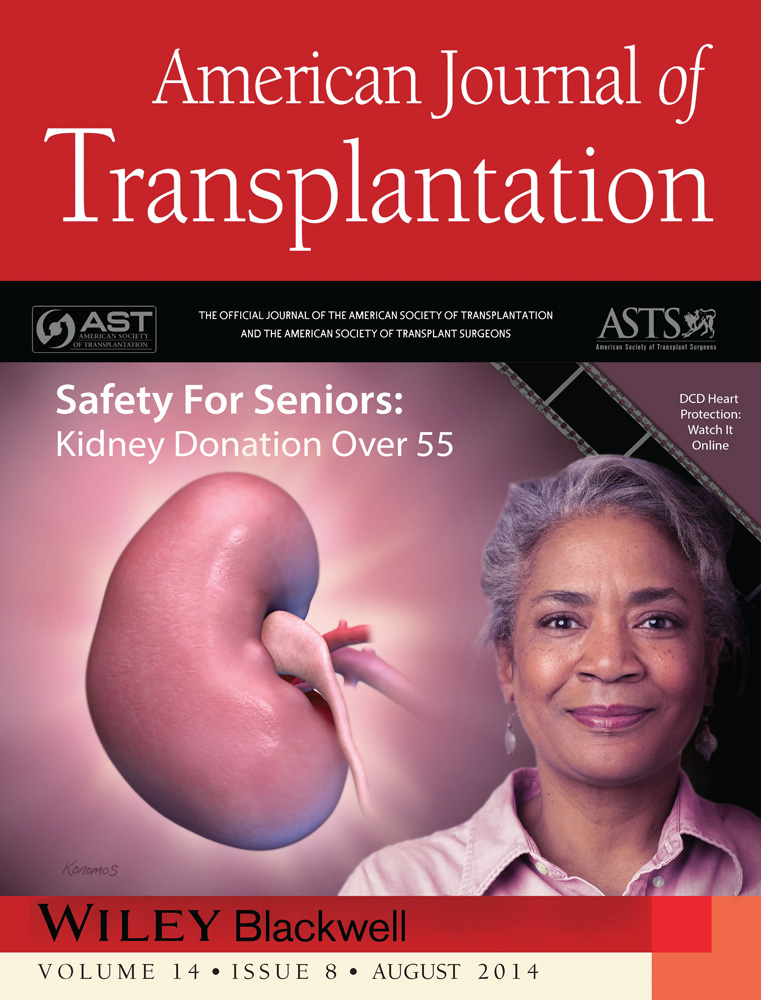The AJT Report
Abstract
Experts in transplantation and related medical fields have a common goal of increasing organ donation in the United States by 1,000 transplants per year for the next five years. This issue of “The AJT Report” looks at how this committee came together, and what the goal will mean for the field. Also this month, we review how a policy interpretation from CMS is impacting offsite organ recovery.

A Collaborative Effort
Planning group suggests a goal of 1,000 more transplants a year for the next five years
Experts in transplantation and related medical fields have come together for the common goal of increasing organ donation in the U.S. by 1,000 transplants per year for the next five years.
Established in 2009 to engage the donation and transplantation community in sustaining the gains seen under the highly successful Breakthrough Collaborative, the Donation and Transplantation Community of Practice (DTCP) is funded by the Health Resources and Services Administration (HRSA).1 The program is coordinated by the Organ Donation and Transplantation Alliance (ODTA) as a demonstration project currently funded through fall 2014.
A DTCP strategic planning committee was formed in late 2012, and in May 2014 the group met and voted to establish the national goal. That goal is currently being vetted by DTCP member organizations and task forces, as well as individuals representing hospitals, transplant centers, donor management and quality improvement (Table 1).
| American Association of Critical Care Nurses |
| American Hospital Association |
| American Society of Transplant Surgeons |
| American Society of Transplantation |
| Association for Multicultural Affairs in Transplantation |
| Association of Organ Procurement Organizations |
| Centers for Medicare and Medicaid Services |
| Donate Life America |
| HRSA |
| Joint Commission |
| NATCO |
| Organ Procurement and Transplantation Network/United |
| Network for Organ Sharing |
| Scientific Registry of Transplant Recipients |
| Society of Critical Care Medicine |
A Stretch, but Doable
LeAnn Swanson, ODTA executive director, believes the shared goal and the collective knowledge of DTCP members will improve transplant rates. “Given that the number of transplants has remained relatively steady over the past several years, it might be somewhat of a stretch goal, but one that I think the committee feels is attainable,” she says. “It was agreed that it needs to be a collaborative effort by all organ procurement organizations, transplant centers and donor hospitals, as well as the public, working together to make it happen.”
According to DTCP strategic planning committee member Teresa Beigay, HRSA's director of special donation services, HRSA is in the process of examining national data and planning an evidence-based review to determine, with community input, new national improvement goals to reflect current population context and realistic performance potential. But, she says, this process takes time. “In the interim, the DTCP strategic planning committee agreed that having a common goal to address collaboratively would be an inspiration for immediate work,” she says. “So, while [the goal of] 1,000 more transplants per year is not officially adopted by HRSA, the DTCP strategic planning committee embraced the idea and will use it in a collective improvement effort.”
KEY POINTS
- A DTCP planning committee established a goal of increasing organ donation by 1,000 transplants per year for the next five years.
- Although not officially adopted by HRSA, the goal will be used in a collective improvement effort by committee members to increase transplant rates.
Commonality
After the DTCP planning committee formed, members created a framework for the group to proceed. They adopted work published by the Stanford Social Innovation Review that focused on “collective impact,” says DTCP strategic committee member Kevin Myer, president/CEO of LifeGift Texas in Houston.2 Collective impact involves the commitment of participants from different sectors to a common agenda for solving a complex social problem.
“I think one of the real values of the DTCP strategic planning committee is that it offers the various stakeholder organizations in transplantation an opportunity to connect on a regular basis to share ideas and report on things that each organization is doing,” says Libby McDannell, executive director of the American Society of Transplantation.
For example, at the May meeting, members of the committee shared initiatives their organizations were undertaking, such as a consensus conference on living donation, efforts by Scientific Registry of Transplant Recipients to revise various performance metrics and measurements, and an Organ Procurement and Transplantation Network plan to look at the ins and outs of data collection.
“The beauty of this is that all these groups around the table are sitting there working it out and looking for commonality,” says Myer. “Sometimes in our field, we spend more time on differences than in looking at what the commonalities are. This is a very different approach.”
Says Beigay, “We often hear that people and organizations ‘work in silos.’ The DTCP strategic planning committee can have a compelling impact on the collective work by aligning activities across the DTCP, decreasing duplication of effort and allowing organizations to build on each other's efforts. This integrated and comprehensive approach will improve our effectiveness and strengthen the public trust in the donation and transplantation system.”
References
Rule Interpretation Impacts Offsite Organ Recovery
Although free-standing organ recovery centers created by organ procurement organizations (OPOs) have the potential to enhance care and decrease its cost, a policy interpretation from the Centers for Medicare and Medicaid Services (CMS) seems to preclude many transplant centers from utilizing these offsite centers.3
Richard Pietroski, executive director of Michigan Gift of Life in Ann Arbor, says that several years ago, one CMS fiscal intermediary (FI) out of 16 nationwide interpreted the cost report form used by transplant centers to mean that an organ has to be physically removed in the transplant center for the center to benefit from certain cost-reporting measures. A center may add the number of organs recovered from deceased donors to their number of transplants to determine their rate of administrative reimbursement. For example, if the center performs 100 transplants and recovers 10 organs, it reports 110 organs to CMS, thus increasing their administrative ratio reimbursement for the year.
Because the CMS rule has a significant financial impact on transplant centers, many centers are unwilling to transfer their patients to the free-standing organ recovery centers.
Under the FI's interpretation of CMS rules, a transplant center could no longer claim organs from brain-dead donors transferred to a free-standing organ recovery center as part of this ratio. Faced with a resulting decline in Medicare reimbursement, transplant centers across the country are now reluctant to send brain-dead donors to the organ recovery centers.

Offsite Recovery Centers
In 2001, Mid-America Transplant Services in St. Louis established the nation's first free-standing organ recovery center and began moving brain-dead donors to this facility.4 Since then, five additional offsite centers have been established. According to Elling Eidbo, executive director of the Association of Organ Procurement Organizations, “these are impressive, state-of-the-art facilities with many resources.”
The centers are also cost-effective. In their 2014 article published in the American Journal of Transplantation, Doyle and his colleagues analyzed liver donors and recipients, donor costs, surgeon hours, and travel time associated with the 915 liver procurements that occurred in their center from April 2001 through December 2011.3 They found that 36% of organ recoveries occurred in the facility the first year, rising to 93% in 2011. Travel time was reduced from eight hours to 2.7 hours, with a reduction in surgeon fly outs by 93% in 2011. Organ recovery costs were reduced by 37% compared with those at an acute care hospital.
However, it is important to note that most brain-dead donors appear to come from hospitals without a transplant center. At the Gift of Life organ recovery center in Michigan, Pietroski says that 80% of donors come from nontransplant hospitals. “There are four types of donors we don't transfer to the offsite center,” Pietroski says. These are donors following circulatory death, brain-dead donors from transplant centers, pediatric donors under age 12—because the ICU and surgical environments are different—and unstable donors.
However, because the CMS rule has a significant financial impact on transplant centers, many centers are unwilling to transfer their patients to the free-standing organ recovery centers. And, development of new free-standing recovery centers has essentially been stopped due to the significant financial impact of the CMS policy on transplant centers. In Chicago, for instance, Gift of Hope built an organ recovery center but is not yet using it because the transplant centers in its area, concerned that Medicare funding would fall, do not want to release brain-dead donors to their center, Eidbo says.
Better Service Despite Negative Financial Impact
In St. Louis, even though organ recovery can occur in the hospital, which benefits financially, Barnes Jewish Hospital utilizes the free-standing facility of Mid-America Transplant Services. “It's probably costing us in excess of $1 million,” says Gene Ridolfi, director of Barnes Jewish Hospital's Organ Transplant Program.
“From our perspective, we knew we were going to take some financial hit, but ultimately, we believed that this was a better service than we could provide in-house ourselves,” he says. “We believe donors are more effectively managed by our OPO staff at their facility than in our ICUs because our physician teams are busy caring for many patients.”
He adds that with advanced donor management, the transplant center hopes to maximize potential donors and increase organ yield. “In the case of a busy center like ours, often operating room schedules are full and potential deceased-donor organ procurement is pushed to the end of the schedule,” Ridolfi says. “It made more sense to move them to an area where they could be better managed and open up our ICU beds for additional patients who might be saved. Also, when families make a decision to donate loved ones' organs they want it to happen relatively quickly, and that's not always the case in a busy hospital.”




